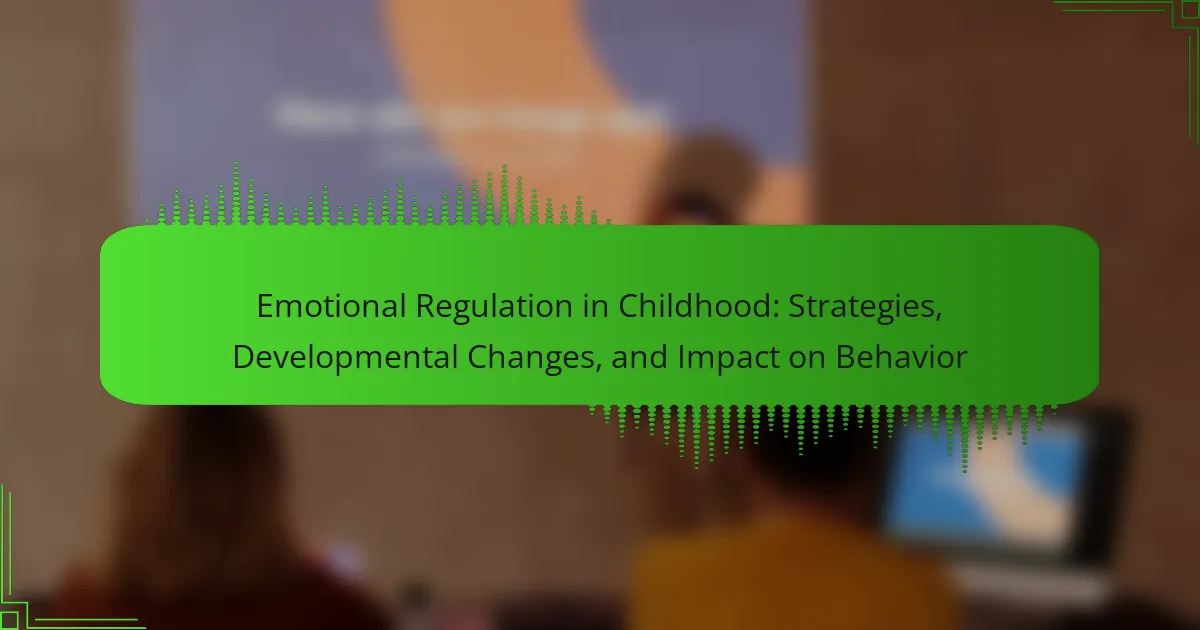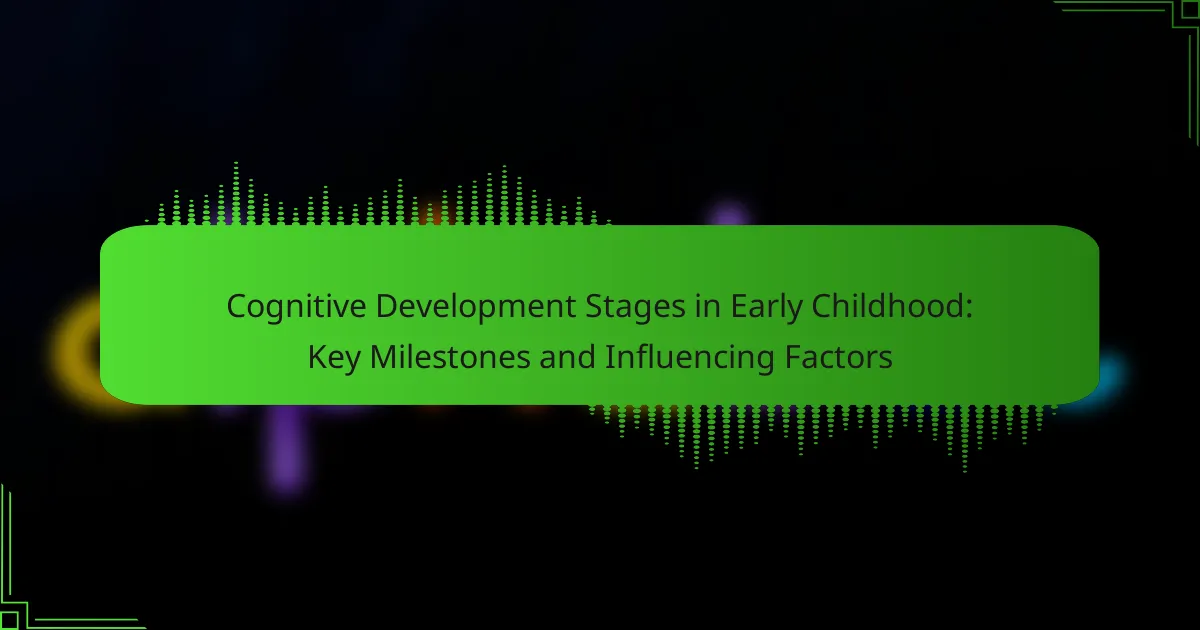Language acquisition in infants is the process through which they learn to comprehend and produce language, beginning at birth and continuing through early childhood. This article explores the various phases of language acquisition, including pre-linguistic, one-word, two-word, and telegraphic speech stages, highlighting key milestones in each phase. It also examines critical periods during which infants are particularly receptive to linguistic input, emphasizing the importance of caregiver interaction and environmental influences on language development. Additionally, the article discusses how exposure to diverse linguistic environments can enhance cognitive flexibility and overall language skills in infants.

What is Language Acquisition in Infants?
Language acquisition in infants is the process through which they learn to understand and produce language. This process begins at birth and continues through early childhood. Infants are exposed to language sounds and patterns from their caregivers. They start by recognizing phonetic sounds and gradually progress to single words. By around 12 months, many infants can say their first words. Research shows that the critical period for language acquisition occurs in the early years of life. During this time, the brain is highly receptive to linguistic input. Studies indicate that infants who are regularly spoken to develop language skills more rapidly. The interaction with caregivers plays a significant role in this developmental process.
How do infants begin to acquire language?
Infants begin to acquire language through a process of listening and imitating sounds. They first engage in cooing around six to eight weeks, producing vowel-like sounds. By around six months, they start babbling, combining consonants and vowels. This babbling is crucial for practicing speech sounds. Infants also respond to the emotional tone of speech before understanding words. They learn to associate sounds with meanings by observing interactions with caregivers. Research shows that social interaction significantly boosts language development. Studies indicate that infants exposed to rich language environments develop language skills more rapidly.
What are the stages of language development in infants?
The stages of language development in infants include cooing, babbling, one-word utterances, and two-word combinations. Cooing typically occurs around 6 to 8 weeks of age, where infants produce vowel-like sounds. Babbling follows, starting around 4 to 6 months, characterized by repetitive consonant-vowel combinations. One-word utterances emerge between 10 to 14 months, where infants begin using single words to convey meaning. Two-word combinations appear around 18 to 24 months, marking the beginning of simple sentence structure. These stages reflect a progression in cognitive and social development, supported by research on infant communication milestones.
What role does imitation play in language acquisition?
Imitation plays a crucial role in language acquisition. It allows infants to mimic sounds, words, and speech patterns they hear from caregivers. This process helps them learn the phonetic and grammatical structures of their native language. Research shows that infants as young as six months engage in vocal imitation. This behavior supports their understanding of social communication. Studies indicate that children who imitate more tend to have better language skills later on. Additionally, imitation fosters interaction between the child and caregiver, enhancing language development. Overall, imitation is a foundational mechanism in the early stages of language learning.
Why is language acquisition important for infants?
Language acquisition is crucial for infants because it lays the foundation for effective communication. Early language skills enable infants to express their needs and emotions. This facilitates social interactions and bonding with caregivers. Research indicates that language development is linked to cognitive growth. Infants who engage in language-rich environments tend to perform better academically later. Furthermore, language acquisition enhances problem-solving and critical thinking skills. Studies show that exposure to multiple languages can boost cognitive flexibility. Thus, language acquisition is vital for overall development in infants.
How does language acquisition affect cognitive development?
Language acquisition significantly enhances cognitive development. It facilitates the formation of neural connections in the brain. Early exposure to language improves memory and problem-solving skills. Children who engage in conversations develop better critical thinking abilities. Studies show that bilingualism can lead to improved executive functions. These include tasks like attention control and task switching. Research indicates that children with rich language environments perform better academically. Language skills also correlate with social-emotional development, fostering better interpersonal skills.
What social skills are influenced by language acquisition?
Language acquisition influences several social skills. These include communication, empathy, and social interaction. Effective communication allows individuals to express thoughts and feelings clearly. Empathy develops through understanding verbal and non-verbal cues in conversations. Social interaction skills improve as children learn to engage with peers. Research indicates that children with strong language skills form better relationships. Studies show that language-rich environments enhance social competence. Thus, language acquisition plays a crucial role in developing essential social skills.

What are the Phases of Language Acquisition?
The phases of language acquisition are pre-linguistic, one-word, two-word, and telegraphic speech stages. In the pre-linguistic phase, infants communicate through crying and cooing. This phase occurs from birth to about 12 months. During the one-word phase, children begin to use single words to convey meaning. This stage typically occurs between 12 to 18 months. The two-word phase follows, where children start combining two words to form simple sentences. This stage usually occurs between 18 to 24 months. Finally, the telegraphic speech phase emerges, characterized by short sentences that include only essential words. This phase typically occurs from 24 months onward. Each phase represents a significant step in the development of language skills in infants.
What are the key phases of language acquisition in infants?
The key phases of language acquisition in infants include cooing, babbling, one-word stage, and two-word stage. Cooing occurs around 6 to 8 weeks, where infants produce vowel-like sounds. Babbling follows between 4 to 6 months, introducing consonant-vowel combinations. The one-word stage appears around 12 months, when infants use single words to convey meaning. By 18 to 24 months, the two-word stage emerges, allowing simple sentences. These phases are supported by developmental milestones observed in early childhood studies, confirming the progression of language skills in infants.
What happens during the pre-linguistic phase?
During the pre-linguistic phase, infants communicate through non-verbal means. This phase occurs from birth to around 12 months. Infants use gestures, [censured] expressions, and vocalizations. They engage in cooing and babbling, which are critical for speech development. This phase is essential for social interaction and bonding. Research indicates that infants respond to the emotional tone of voices. They also begin to recognize their caregivers’ voices. These interactions lay the groundwork for later language development.
How do infants transition from babbling to first words?
Infants transition from babbling to first words through a gradual process of sound refinement and meaning association. Initially, infants produce repetitive consonant-vowel combinations known as babbling. This stage typically occurs around six months of age. As they approach their first birthday, infants begin to produce more varied sounds and syllable structures. They also start to associate specific sounds with objects or actions. This connection is crucial for language development. Research shows that infants’ exposure to language influences this transition. Engaging with caregivers through speech enhances their ability to form words. By around 12 months, most infants articulate their first recognizable words. These words often relate to familiar people or objects in their environment.
How do these phases impact later language skills?
The phases of language acquisition significantly impact later language skills. These phases include pre-linguistic, one-word, and multi-word stages. Each phase builds a foundation for vocabulary and grammar. For instance, the pre-linguistic phase involves babbling, which develops phonetic awareness. This awareness is crucial for understanding sounds in later language use. The one-word phase introduces basic vocabulary, allowing for initial communication. Children learn to associate words with meanings during this stage. The multi-word phase expands sentence structure and grammatical understanding. Research shows that children exposed to rich language environments during these phases develop stronger language skills. A study by Hart and Risley (1995) found that children from language-rich homes had larger vocabularies by age three. Thus, these phases directly influence the complexity and proficiency of later language skills.
What are the long-term effects of early language acquisition phases?
Early language acquisition phases lead to enhanced cognitive development and improved communication skills in the long term. Children who acquire language early show better academic performance later in life. Studies indicate that early language exposure correlates with higher IQ scores. Additionally, these children often develop stronger social skills and emotional intelligence. Research from the University of Chicago shows that early language skills predict later literacy success. Furthermore, bilingual children who start language acquisition early exhibit greater cognitive flexibility. These long-term effects underscore the importance of early language exposure in childhood development.
How does the timing of language exposure influence outcomes?
The timing of language exposure significantly influences language acquisition outcomes in infants. Early exposure to language, particularly during critical periods, enhances the ability to learn and process language. Research indicates that infants exposed to language before the age of three develop stronger linguistic skills compared to those who are exposed later. For instance, studies show that children who hear a rich language environment in their early years score higher on language assessments. Additionally, critical periods suggest that there are optimal windows for language learning, where neural plasticity is at its peak. Delayed exposure can result in difficulties in pronunciation, grammar, and vocabulary acquisition. Thus, the timing of language exposure plays a crucial role in shaping linguistic capabilities.

What are the Critical Periods in Language Acquisition?
Critical periods in language acquisition refer to specific time frames during which individuals are particularly receptive to language learning. Research indicates that these periods are most pronounced in early childhood, typically from birth to around age seven. During this time, children can acquire language skills more easily and effectively than at later stages. For instance, studies show that children exposed to language during this critical period develop native-like proficiency. Conversely, missing exposure during these years can lead to significant challenges in language development. This phenomenon has been supported by cases such as that of Genie, a girl who was isolated until age 13, demonstrating severe language deficits due to missed critical periods.
What is the significance of critical periods in language development?
Critical periods in language development are essential windows of time for acquiring language skills. During these periods, children are particularly sensitive to linguistic input. Research shows that if language exposure occurs outside these critical windows, it can lead to significant delays or deficits in language acquisition. For instance, studies indicate that children who are not exposed to language before the age of seven struggle to achieve full proficiency later. This highlights the importance of early interaction and communication for optimal language development.
How does brain plasticity relate to critical periods?
Brain plasticity is crucial during critical periods of development. Critical periods are specific time frames when the brain is particularly receptive to learning and adapting. During these windows, neural connections are formed rapidly in response to environmental stimuli. For instance, language acquisition occurs most effectively in early childhood due to heightened brain plasticity. Research shows that children exposed to language during these periods develop stronger linguistic abilities. Conversely, missing these critical periods can hinder language development, as the brain becomes less plastic with age. This relationship underscores the importance of timely exposure to language for optimal cognitive growth.
What evidence supports the existence of critical periods?
Critical periods are specific windows of time during which certain skills or abilities can be most effectively developed. Evidence supporting their existence includes research on language acquisition in infants. For example, studies by Lenneberg (1967) indicate that children who are not exposed to language during early years struggle to acquire it later. Additionally, neurological studies show that the brain’s plasticity decreases with age, particularly in the first few years of life. Research by Johnson and Newport (1989) demonstrated that individuals who learned a second language after puberty had significantly lower proficiency than those who learned it earlier. These findings collectively support the concept of critical periods in language development.
How can disruptions during critical periods affect language acquisition?
Disruptions during critical periods can severely hinder language acquisition. Critical periods are specific developmental windows when the brain is particularly receptive to language learning. During these times, exposure to language is crucial for proper linguistic development. Disruptions can include factors such as lack of social interaction, hearing impairments, or environmental instability. Research shows that children deprived of language exposure during these critical windows often struggle with language skills later in life. For instance, studies indicate that children who experience social isolation may face significant delays in vocabulary and grammar. These disruptions can lead to long-term deficits in communication abilities and cognitive development.
What are the potential impacts of delayed language exposure?
Delayed language exposure can lead to significant developmental impacts. Children may experience difficulties in speech and language skills. These challenges can manifest as limited vocabulary and poor grammar. Social interactions can also be affected, leading to potential isolation. Cognitive development may suffer as language is crucial for learning. Research indicates that early exposure is vital for optimal language acquisition. A study by Hart and Risley (1995) found that children with limited language exposure had lower IQ scores. Delayed exposure can hinder academic performance later in life. Overall, timely language exposure is essential for healthy development.
How do environmental factors play a role during critical periods?
Environmental factors significantly influence language acquisition during critical periods in infants. These factors include social interaction, exposure to language, and the richness of the linguistic environment. Infants learn best when they are engaged in meaningful communication with caregivers. Research shows that children who experience varied linguistic input develop stronger language skills. For instance, studies indicate that bilingual exposure can enhance cognitive flexibility. Additionally, the emotional tone of interactions affects language learning. Positive and supportive environments foster better language outcomes. In contrast, neglectful or impoverished linguistic environments can hinder language development. Overall, environmental factors are crucial for optimizing language acquisition during these sensitive developmental windows.

What Environmental Influences Affect Language Acquisition?
Environmental influences that affect language acquisition include social interaction, exposure to language, and cultural context. Social interaction with caregivers and peers provides essential feedback and reinforcement. Frequent verbal communication promotes vocabulary development and grammatical understanding. Exposure to diverse linguistic inputs enhances phonetic awareness and comprehension. Cultural context shapes the language used and the values conveyed through communication. Research indicates that children in language-rich environments outperform peers in language skills. Studies show that infants exposed to multiple languages develop greater cognitive flexibility. Thus, the quality and quantity of linguistic exposure significantly impact language acquisition outcomes.
How does the home environment contribute to language development?
The home environment significantly contributes to language development in infants. It provides the primary context for language exposure and interaction. Infants learn language through listening to caregivers speak. Frequent verbal interactions enhance vocabulary acquisition. Reading aloud to children fosters comprehension skills. A rich linguistic environment encourages expressive language use. Studies show that children from language-rich homes have larger vocabularies. For instance, Hart and Risley (1995) found that children in affluent families heard 30 million more words by age three than those in lower-income families. This disparity influences their language skills and academic performance later in life.
What role do caregivers play in language acquisition?
Caregivers play a crucial role in language acquisition by providing essential linguistic input. They engage in frequent verbal interactions with infants, which facilitates exposure to vocabulary and grammatical structures. Caregivers often model language through repetition and expansion of the child’s attempts at speech. This interaction helps infants to learn the sounds, rhythms, and patterns of their native language. Research indicates that responsive caregiving enhances language development. A study by Hart and Risley (1995) found that children from language-rich environments had larger vocabularies compared to those with less verbal interaction. Thus, caregivers significantly influence the pace and quality of language acquisition in infants.
How does socioeconomic status influence language exposure?
Socioeconomic status significantly influences language exposure. Higher socioeconomic status often correlates with increased access to resources that promote language development. Families with higher income levels typically engage in more verbal interactions with their children. They tend to provide a richer linguistic environment through books, educational toys, and activities. In contrast, lower socioeconomic status may limit access to such resources. Children from lower-income families often experience fewer words spoken to them daily. Research indicates that by age three, children from wealthier families may hear up to 30 million more words than their less affluent peers. This disparity can lead to differences in vocabulary and language skills as children grow.
What impact does early childhood education have on language skills?
Early childhood education significantly enhances language skills. It provides structured opportunities for children to engage in language-rich environments. These environments often include storytelling, songs, and interactive play. Research shows that children exposed to early education programs have larger vocabularies. They also demonstrate better grammar and communication skills. A study by the National Institute for Early Education Research found that preschool attendance correlates with improved language outcomes. Children in quality early childhood programs exhibit advanced language processing abilities. This early exposure lays a foundation for future academic success in language-related subjects.
What types of educational programs are most effective for language acquisition?
Immersive language programs are most effective for language acquisition. These programs involve extensive exposure to the target language in natural contexts. Research shows that immersion leads to higher proficiency levels compared to traditional methods. A study by Genesee (2004) highlights that children in immersion programs outperform peers in vocabulary and grammar. Additionally, interactive approaches, such as play-based learning, enhance engagement and retention. Programs that incorporate cultural elements also promote deeper understanding. Evidence suggests that social interaction within these programs improves communicative skills. Therefore, immersive and interactive educational programs are key for effective language acquisition.
How can parents support language development through activities?
Parents can support language development through interactive activities. Engaging in conversations with infants enhances their vocabulary and comprehension. Reading books aloud introduces new words and concepts. Singing songs promotes phonetic awareness and rhythm. Playing with toys that encourage verbal interaction fosters communication skills. Encouraging storytelling allows children to express thoughts and ideas. Providing a rich language environment supports cognitive growth. Research indicates that children exposed to diverse language experiences develop stronger language skills.
What are practical tips for fostering language acquisition in infants?
Engaging in frequent verbal interactions is essential for fostering language acquisition in infants. Talking to infants during daily routines helps them associate sounds with actions. Reading aloud to infants introduces them to new vocabulary and sentence structures. Singing songs and nursery rhymes enhances their phonetic awareness. Responding to an infant’s coos and babbles encourages them to communicate. Using varied tones and expressions makes language more engaging. Providing a language-rich environment with diverse sounds and words supports their development. Research shows that these practices significantly enhance language skills in early childhood.
Language acquisition in infants is the process through which they learn to understand and produce language, beginning at birth and continuing through early childhood. This article explores the key phases of language development, including cooing, babbling, and the transition to one-word and two-word utterances, highlighting the critical periods when the brain is most receptive to linguistic input. It also examines the significant role of caregivers, social interaction, and environmental factors in shaping language skills, as well as the long-term impacts of early language exposure on cognitive and social development. Understanding these components is essential for fostering effective language acquisition in infants.



